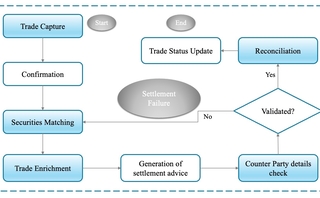Banks express concern over top venues’ bid for EU consolidated tape
End-users are worried about the repercussions of handing over a data monopoly to the heavyweight operators in the fixed income space.

Banks and asset managers are concerned that a venue-led consolidated tape (CT) for fixed income—run by Bloomberg, Tradeweb, and MarketAxess—would enhance investment firms’ reliance on a small group of operators in the bond markets and solidify the venues’ dominance in the space.
“When I found out about the consortium being put in place, my view was that this is not a good decision for us, the consumer side,” says a senior market data lead at a European-based investment bank.
That market data fees are too high is certainly not a new complaint from banks and asset managers. In the case of a fixed-income CT specifically, the fear is that too much power over the market data will be consolidated in the hands of three data vendors, and with a regulatory seal of approval.
“It’s not good because we already suffer,” says the market data lead. “The fact that those players who own the top trading platforms could therefore own all the data coming out of it—they will have too much skin in the game for my liking.”
The three big venues confirmed in June that they were planning to compete for the contract to deliver the regulator-backed tape for bonds. WatersTechnology first broke the news of their plans back in November 2021.
The three venues are in the process of selecting an independent technology partner to build the tape. Although their relationship with the vendor remains unclear, the consortium said in November that it intends to select its partner ahead of the regulator’s public tender.
Six months on from the announcement, some bank executives are worrying that awarding the CT contract to the consortium will entrench these fixed-income giants’ dominance of the market. Collectively, they already see most electronic trading volume in fixed-income markets in the European Economic Area (EEA). Data published by the European Securities and Markets Authority (Esma) showed that, in 2019, the three venues accounted for 84% of all bond market volume traded on multilateral trading facilities (MTFs) in the region, which amounts to €12.6 trillion ($14.2 trillion).
WatersTechnology spoke to 10 sources for this story, five of whom featured are senior executives at investment firms.
These end-user sources say the fixed-income venues are vying for the CT contract for two main reasons: to protect their existing data businesses, where it is seen as better to become the guardian of the cheap service than surrender it to a competitor; and to gain first-hand access to all the tape data, thereby creating new, value-added analytics at a premium.
All three venues are designated MTFs and run approved publication arrangements (APAs). Under the Markets in Financial Instruments Directive (Mifid II), they can collect and publish post-trade data on behalf of investment firms that have not traded on a bond market venue; that is, over the counter or via a systematic internalizer (SI). In addition to the trade data they capture through their MTFs, the venues collect and house a large proportion of the off-venue data via their APAs.
If they do win the contract, all venues, APAs, SIs, and investment firms would have to submit their trade information to their tape.
“That could be a great concern because they would have a lot of control over the CTP, the data, the commercial models, the latency, and a lot of that activity,” says a market structure lead at a second EU-based investment bank.
Conflict of interest?
Generally, users are worried about what a venue-led tape might look like, how it will be governed, and if it will meet the EU regulator’s proposals to deliver a CT on “a reasonable commercial basis”.
A big factor in all of this, say critics, is that the CT will overlap with the venues’ existing market data businesses. The emergence of a cheap post-trade feed for fixed income will by definition eat into the venues’ data revenues.
I’m afraid if they create the CTP, it will be low value. For people who still want or need to buy high-value data, they will still have to use the APAs or the trading venues’ market data businesses
Market structure lead at European bank
The market structure lead says this gives the consortium little incentive to produce a high-quality tape or invest in what should become a utility service. The feed’s latency or the quality of the data are among the areas that would need improving over time.
“I’m afraid if they create the CTP, it will be low value,” says the market structure lead. “For people who still want or need to buy high-value data, they will still have to use the APAs or the trading venues’ market data businesses.”
The head of regulatory affairs at a third European investment bank agrees that any tape provider will have to demonstrate that it can rectify the data quality issues that have stifled the emergence of a tape since it was first provisioned under Mifid II in 2018.
However, there are conflicting views in the industry as to who should be responsible for ensuring the data is up to scratch. Some say regulators should put pressure on the future CTP or the APAs to standardize the data, while others say the responsibility should sit with the investment firms reporting the trades.
In an interview with WatersTechnology in June, Neil Ryan—the CT lead at Finbourne, which is one of the candidates hoping to become the bond-market CT provider—said that oversight of the tape and data standards should reside with the regulator, whereas the tape provider should be focused on operational matters.
“We feel the focus should really be on operational issues, and the technology as part of that,” he said. “But there are other things like measuring and managing the input and output of data, measuring the volume, billing—all that sort of boring stuff—the legal aspects, the IP, the redistribution, and invoicing. All those things must be built out.”
Price tag
The most contentious part of the debate, and the issue users care about the most, is how much the CT will cost. Mifid II stipulates that it must be delivered on a reasonable commercial basis, but what that means is unclear and is yet to be defined by Esma.
One head of trading at a European-based asset manager is among those concerned about how much users will be charged. They say they have struggled with year-on-year price rises in the cost of market data and that any provider must operate the CT as a low-cost utility pursuant to Mifid provisions.
“The raw data is a pure commodity and should come at a very low price,” the buy-side source adds.
Over time we believe markets will demand tools and analytics utilizing this data, and that will spur further innovation and healthy competition between and among firms like ours and others
Joint statement by Bloomberg, MarketAxess and Tradeweb
The venues themselves say they agree with this sentiment. In a joint statement, the three venues told WatersTechnology that the purpose of the tape is “to provide robust, high-quality raw data to the markets as an independent, Esma-regulated entity, with a cost-recovery commercial model”.
Competition will be crucial if the cost is to be kept down, the buy-side source says. For years, many providers viewed the CT as a “poisoned chalice” that would require a large upfront investment and reap little year-on-year return. However, some firms can now see the benefits of having exclusive access to, and ownership of, the industry’s raw bond market data—and the value-add analytics products that can be built off of that data.
Some vendors are even using a bid for the CT as a platform to raise their profile.
“They’re unknown quantities in the industry,” says the CEO of a data governance vendor. “Getting involved in this means they can get their name out there and, whether they’re successful or not, they’ve already achieved their mission.”
Over the last few years, some interested parties have stepped forward. Among them are pure tech firms Finbourne, Ediphy, Propellant, Opensee and E-trading Software, in addition to the venue-led consortium.
“I’m a big advocate of having competition, as of now, but it will also be relevant in five years’ time when a new contract will be awarded,” the buy-side source says. “Because only competition will lead to prices staying at an optimal level for end users.”
One managing partner at a tech consultancy firm says that although there are many contenders entering the race, none has presented anything that looks like a commercially viable product. The source adds that there are “obvious money constraints” in trying to invest in a service that will take years to recover costs.
There are many market participants, including the venues themselves who believe their bid for the CT makes sense. As regulated MTFs with APAs, they have expertise in aggregating data.
In the same statement, the venues say they are “uniquely qualified to deliver a consolidated tape service that meets the needs of market participants and the objectives of the regulators, drawing on our collective expertise in fixed income markets and in operating regulatory reporting entities including APAs and Approved Reporting Mechanisms (ARMs) for Mifir reporting.”
They also say that, indeed, they would be best placed to add value to the tape with differentiated products.
“Over time we believe markets will demand tools and analytics utilizing this data, and that will spur further innovation and healthy competition between and among firms like ours and others,” the three venues said in the same statement this month.
What’s next?
Next year could see a lot of progress toward the establishment of a CT in the EU. In the second half of the year, Esma is expected to launch its tender process, so time is ticking for hopeful candidates to prepare viable solutions.
Sources spoken to for this article say they would prefer the tape to be run by a single independent third-party vendor.
One senior market data lead at a fourth large, global bank, but who is based in Europe, believes that the EU should avoid following the same path as the US equities model, whereby the region’s top US exchanges, Nasdaq, and the New York Stock Exchange, have long operated the two tapes—otherwise known as the Securities Information Processors (Sips)—but is now undergoing a major restructuring to allow for multiple competing consolidators to come forward.
“That is another consideration that we should try to avoid here [in the EU],” said a senior market data lead, who was speaking at this year’s World Financial Information Summit in October.
In many cases, the end users want an independent operator to run the tape to avoid any ulterior motives or vested interests interfering with the quality of the data or the price of the raw data feed.
To alleviate some of the concerns about the tape’s governance, the venues are planning to establish a standalone entity and are in the process of selecting an independent technology partner to work with.
Added to that, the nominated provider will also be an authorized entity and supervised by Esma. This means that the appointed CTP will first be required to meet the criteria set out in the tender and play by the rules under the watchful eye of the regulator for the full term of the five-year contract.
The consortium intends to select its partner ahead of Esma’s public tender, the three operators wrote in a joint response in November.
It is still, however, unclear how the role dynamics between the venues and the vendor will play out. The consortium’s governance framework will become a big decider in whether they win the contract, which would grant them the rights to a regulatory-backed data monopoly.
Sassan Danesh, managing director at E-Trading Software—a provider of reference data for derivatives and market data solutions that hopes to become the CTP—says there will need to be strict controls in place for a venue-led CT to work and for policymakers to offer the green light.
“It doesn’t mean that it can’t be addressed, of course, but it would need significant governance and controls over how such an entity would operate,” Danesh adds. “Pure fintechs don’t have that particular challenge and they can just focus on [providing] good technology and operations…without worrying about the cannibalization of existing business lines.”
Only users who have a paid subscription or are part of a corporate subscription are able to print or copy content.
To access these options, along with all other subscription benefits, please contact info@waterstechnology.com or view our subscription options here: http://subscriptions.waterstechnology.com/subscribe
You are currently unable to print this content. Please contact info@waterstechnology.com to find out more.
You are currently unable to copy this content. Please contact info@waterstechnology.com to find out more.
Copyright Infopro Digital Limited. All rights reserved.
You may share this content using our article tools. Printing this content is for the sole use of the Authorised User (named subscriber), as outlined in our terms and conditions - https://www.infopro-insight.com/terms-conditions/insight-subscriptions/
If you would like to purchase additional rights please email info@waterstechnology.com
Copyright Infopro Digital Limited. All rights reserved.
You may share this content using our article tools. Copying this content is for the sole use of the Authorised User (named subscriber), as outlined in our terms and conditions - https://www.infopro-insight.com/terms-conditions/insight-subscriptions/
If you would like to purchase additional rights please email info@waterstechnology.com
More on Trading Tech
For MarketAxess, portfolio trading buoys flat revenue in Q3
The vendor is betting on new platforms like X-Pro and Adaptive Auto-X, which helped forge a record quarter for platform usage.
Quants look to language models to predict market impact
Oxford-Man Institute says LLM-type engine that ‘reads’ order-book messages could help improve execution
JP Morgan pulls plug on deep learning model for FX algos
The bank has turned to less complex models that are easier to explain to clients.
Nasdaq says SaaS business now makes up 37% of revenues
The exchange operator’s Q3 earnings bring the Adenza and Verafin acquisitions center stage.
Harnessing generative AI to address security settlement challenges
A new paper from IBM researchers explores settlement challenges and looks at how generative AI can, among other things, identify the underlying cause of an issue and rectify the errors.
The causal AI wave could be the next to hit
As LLMs and generative AI grab headlines, another AI subset is gaining ground—and it might solve what generative AI can’t.
Waters Wrap: Operational efficiency and managed services—a stronger connection
As cloud, AI, open-source, APIs and other technologies evolve, Anthony says the choice to buy or build is rapidly evolving for chief operating officers, too.
BlackRock forecasts return to fixed income amid efforts to electronify market
The world's largest asset manager expects bond markets to make headway once rates settle.








